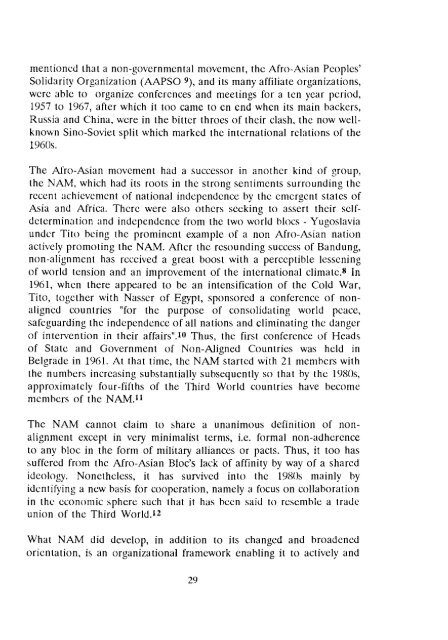ifda dossier 74 - Dag Hammarskjöld Foundation
ifda dossier 74 - Dag Hammarskjöld Foundation
ifda dossier 74 - Dag Hammarskjöld Foundation
Create successful ePaper yourself
Turn your PDF publications into a flip-book with our unique Google optimized e-Paper software.
mentioned that a non-governmental movement, the Afro-Asian Peoples'<br />
Solidarity Organization (AAPSO 9), and its many affiliate organizations,<br />
were able to organize conferences and meetings for a ten year period,<br />
1957 to 1967, after which it too came to cn end when its main backers,<br />
Russia and China, were in the bitter throes of their clash, the now well-<br />
known Sino-Soviet split which marked the international relations of the<br />
1960s.<br />
The Nro-Asian movement had a successor in another kind of group,<br />
the NAM, which had its roots in the strong sentiments surrounding the<br />
recent achievement of national independence by the emergent states of<br />
Asia and Africa. There were also others seeking to assert their self-<br />
determination and independence from the two world blocs - Yugoslavia<br />
under Tito being the prominent example of a non Afro-Asian nation<br />
actively promoting the NAM. After the resounding success of Bandung,<br />
non-alignment has received a great boost with a perceptible lessening<br />
of world tension and an improvement of the international climate.8 In<br />
1961, when there appeared to be an intensification of the Cold War,<br />
Tito, together with Nasser of Egypt, sponsored a conference of non-<br />
aligned countries "for the purpose of consolidating world peace,<br />
safeguarding the independence of all nations and eliminating the danger<br />
of intervention in their affairs".10 Thus, the first conference of Heads<br />
of State and Government of Non-Aligned Countries was held in<br />
Belgrade in 1961. At that time, the NAM started with 21 members with<br />
the numbers increasing substantially subsequently so that by the 1980s,<br />
approximately four-fifths of the Third World countries have become<br />
members of the NAM.11<br />
The NAM cannot claim to share a unanimous definition of non-<br />
alignment except in very minimalist terms, i.e. formal non-adherence<br />
to any bloc in the form of military alliances or pacts. Thus, it too has<br />
suffered from the Afro-Asian Bloc's lack of affinity by way of a shared<br />
ideology. Nonetheless, it has survived into the 1980s mainly by<br />
identifying a new basis for cooperation, namely a focus on collaboration<br />
in the economic sphere such that it has been said to resemble a trade<br />
union of the Third World.12<br />
What NAM did develop, in addition to its changed and broadened<br />
orientation, is an organizational framework enabling it to actively and
















